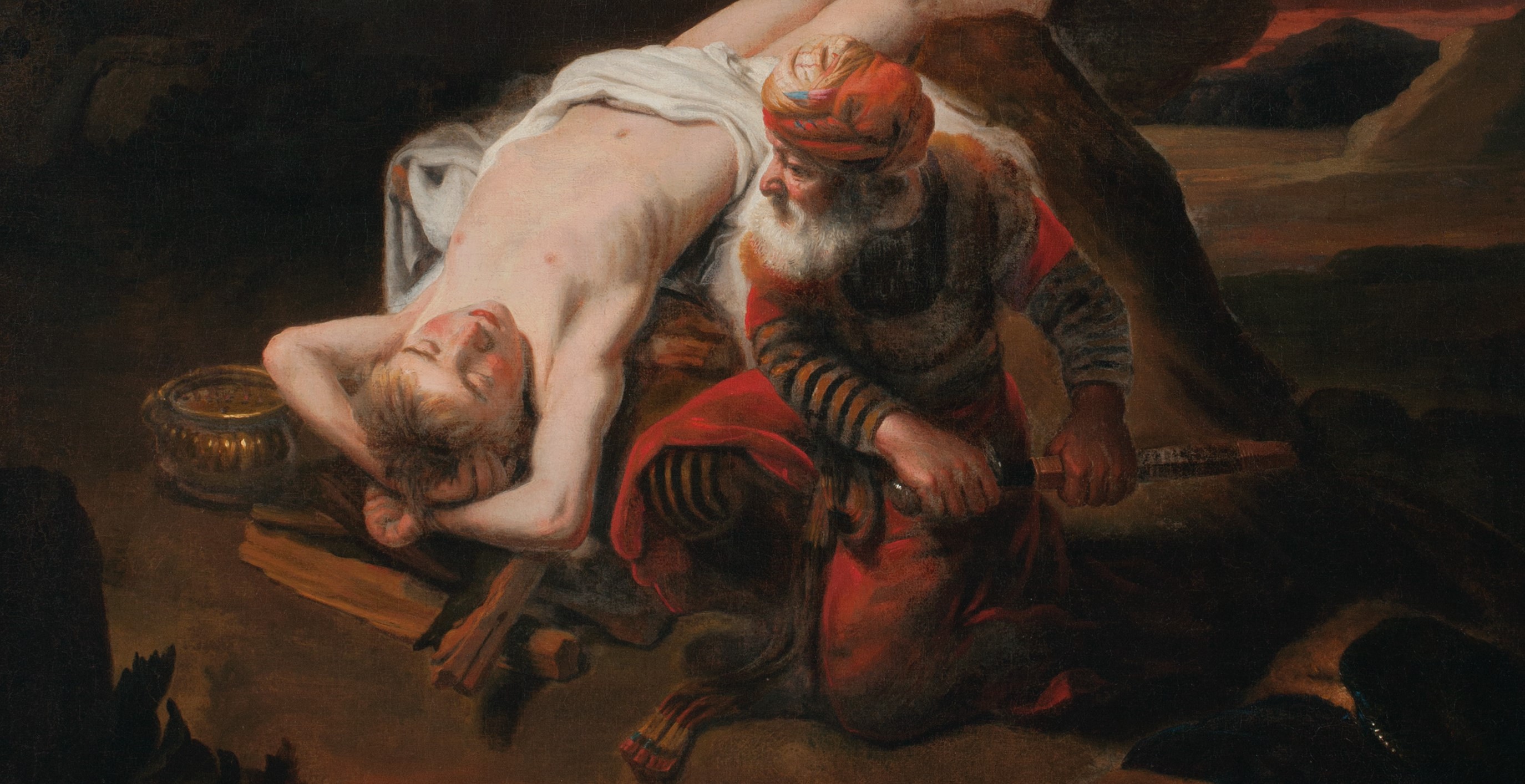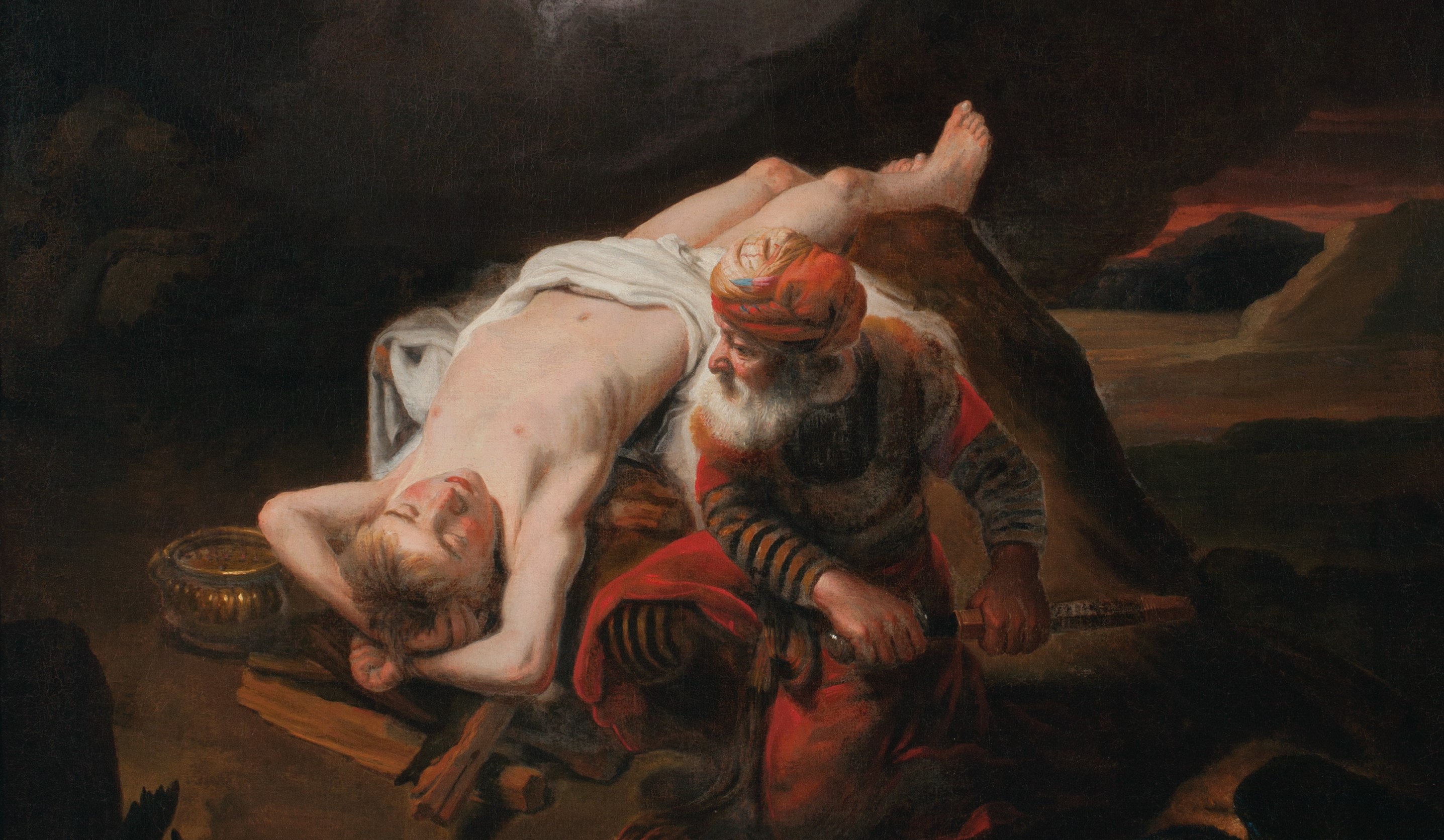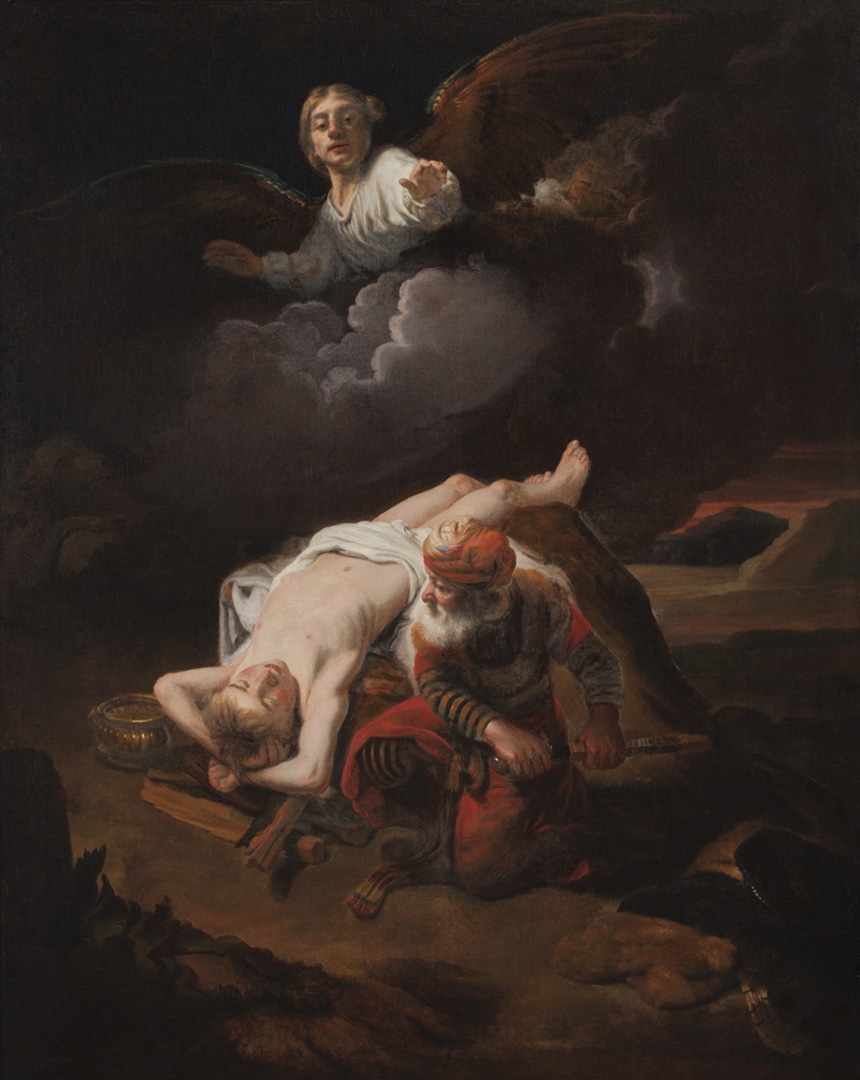
In this reinterpretation of Nicolaes Maes’s Abraham’s Sacrifice, a seventeenth-century Dutch painting that visualizes the Biblical story of the near sacrifice of Isaac at the hands of his own father,1“Abraham’s Sacrifice,” Collections, Agnes Etherington Art Centre, accessed March 6, 2024, Web. I introduce a queer lens that privileges the body as an erotic site within artworks that are traditionally understood as religious. Here, we not only consider how this way of looking highlights the role of emotions in seventeenth-century paintings, but also how the contemporary spectator’s queer engagement with the piece enables eroticism to thematically emerge.2Contemporary in this article refers to the present-day as a temporal period.
“When they reached the place God had told him about, Abraham built an altar there and arranged the wood on it. He bound his son Isaac and laid him on the altar, on top of the wood. Then he reached out his hand and took the knife to slay his son. But the angel of the Lord called out to him from heaven, “Abraham! Abraham!”
EDGING: THEN AND NOW
To even think about a sexual re-reading of an important Biblical painting, a visualization of the passage above, can be unnerving, especially as it challenges its normative meaning. But to “queer” something does not simply refer to a reading that superimposes queer culture—“queering,” as I use it in this examination of Abraham’s Sacrifice, is a way of opening a visual analysis to “multifaceted, iterative, and complex identity dynamics,” as Bryan C. Keene and Rheagan Martin state.3Bryan C. Keene and Rheagan Martin, “Coming Out: Queer Erasure and Censorship from the Middle Ages to Modernity,” News & Stories, Getty, last modified October 11, 2016, Web. Queering, in our case, is about moving beyond an artwork’s traditional meaning, deviating4Deviation within queer scholarship refers to instances where an object or occurrence does not align with normative meanings. Sara Ahmed, Queer Phenomenology: Objects, Orientations, Others (Durham: Duke University Press, 2006); Heather Love, Underdogs: Social Deviance and Queer Theory (Chicago: University of Chicago Press, 2021); José Esteban Muñoz, Disidentifications: Queers of Colours and the Performance of Politics (Minnesota: University of Minnesota Press, 1999). from it and bringing it into the realm of intellectual and methodological intervention. To this end, reading something in a queer way incites examinations of subversive interpretations outside of religious conventions—and in our case, an eroticization of the sacrificial story of Isaac .
This is what Maes painted on the canvas: centred in this visual narrative is Isaac, a young man whose supple body has been stripped. His nude figure, covered by a mere loincloth draped over his genitals, proposes itself as the main focus for the spectator’s gaze. With hands tied behind his head and lying upon the altar built of rock and wood, he gently closes his eyes as he awaits his father’s knife to pierce his flesh. As heavenly light breaks the clouds, significant attention is drawn to Isaac’s illuminated appearance. His pale skin and white loincloth create a stark visual contrast between himself and his father, whose scarlet robes foreshadow the blood meant to be spilt in this sacrifice, further highlighting his vulnerability and innocence. His father kneels and draws his knife to commence the sacrificial offering, but as he unsheathes it, God’s angel appears. In the Biblical passage, the angel halts Isaac’s death by exclaiming “Abraham! Abraham!” However, despite this fortunate turn of events, Maes chose to depict the moment right before it happens—the split-second instance between Isaac’s living and dying. In Maes’s decision to paint this moment, he has left the spectator on edge through the narrative cliff-hanger of the sacrificial drama—visually suspending the spectator between the instances of execution and salvation. But why?
As a student of Rembrandt van Rijn, apprenticed between 1648 and 1653, Maes was influenced by his master’s aesthetic predilections, which included a foregrounding of evocatively rendered “passions.” The term “passions” in the seventeenth century did not refer to our contemporary sense of the word, such as erotic passions, but rather emotions as understood at the time.5Lara Yeager-Crasselt, “Pieter Lastman’s David’s Uriah: Storytelling and the Passions,” in The Leiden Collection Catalogue, 4th ed., ed. by Arthur K. Wheelock Jr and Elizabeth Nogrady with Caroline Van Cauwenberge (New York: The Leiden Collection, 2023), accessed 25, 2024, Web. In painting, this included dramatic emotion invoked through images, better defined through the Dutch term oogenblikkige beweging (literally: movement in the blink of an eye), which denotes a focus on suddenness in both portrayed action and affective reaction.6Samuel van Hoogstraten notes the term oogenblikkige beweging as an element learned from Rembrandt, in his Inleyding Tot De Hooge Schoole Der Schilderkonst: Anders de Zichtbaere Werelt from 1678. Maes would have likely been trained in this concept to benefit his paintings. Eric Jan Sluijter, Rembrandt’s Rivals: History Painting in Amsterdam 1630-1650 (Amsterdam: John Benjamins, 2015), 49-50; Thijs Weststeijn, The Visible World: Samuel van Hoogstraten’s Art Theory and the Legitimation of Painting in the Dutch Golden Age (Amsterdam: Amsterdam University Press, 2008), 185. Maes’s rendering of the sacrificial scene, choosing the moment in which Isaac’s life is seconds away from being spared but is threatened by Abraham’s blade, makes the spectator feel the rush of anticipation, wanting a sense of release from the near climax of the image.
These moments of anticipation are similarly present in contemporary BDSM,7BDSM refers to “bondage and discipline, dominance and submission, and/or sadomasochism.” Brandy L. Simula, “Pleasure, Power, and Pain: A Review of the Literature on the Experience of BDSM Participants,” Sociology Compass 13, no. 3 (2019): 2, Web. especially within the context of edge play. Edge play is a specific type of BDSM scene8BDSM scene is used in this article as a commonly used term to describe a sexual play or role play scene. Christine Steinmetz and Paul J. Maggins, eds., “The Landscapes of BDSM Venues,” in (Sub)Urban Sexscapes (London: Routledge, 2014). which involves edging, the activity of bringing someone closer to sexual release or climax but withholding it for a prolonged period of time. Edging heightens the sensual experience of the participant. One might even argue that Maes’s methodology to manipulate “passions” was an edging of its own kind—edging the spectator and stirring their emotions. This idea of edging is central to our erotic reading of Isaac and his submissiveness, a dynamic that we now turn to.

“He bound his son Isaac and laid him on the altar […] then he reached out his hand and took the knife to slay his son.”
Maes’s painted rendition of this sacrificial story takes the passage above as an entry point, opening it up for a reading that draws on bondage and sadomasochism as interpretive frames.9Sacrificial stories are quite common in the Bible, with examples such as the sacrifice of Isaac in the Hebrew Bible foreshadowing the sacrifice of Christ in the New Testament where both characters are referred to as “lambs” in their own narratives. Genesis 22:6-11; John 1:29 (NIV). In addition to Isaac’s pose, in which he is physically restrained, his father Abraham insists on his subdued nature as he commits the sacrificial offering as priest in this oblation. Edge play forms a generative point of departure as it allows us to explore the liminal space where Isaac teeters on the brink of life and death, which the spectator grapples with as they engage with the image. Isaac’s obedient portrayal arrests the viewer’s attention through its visceral qualities and activates an erotic mode of viewing due to the way his body is positioned and illuminated. In the painting, Isaac assumes the position of the subdued participant—but to whom is he submitting? A contemporary queer perspective inserts itself by inquiring into the methods and erotics of spectatorship and how power is operationalized. BDSM draws on power dynamics between participants, and in Maes’s painting, despite Abraham’s pre-configuration as the one wielding the blade, he is not the most powerful character—in fact, it is God. But who is God in this painting?
Queer Spectating Power
At this point, I am not only queering Maes’s rendition of the sacrifice of Isaac as a visual mirror of contemporary edge play and BDSM, but I am also queering the method of spectatorship that the reader has been participating in since reading this essay. The erotic exchange in our visual analysis is taking place between Isaac and us, the spectator, and even between Isaac and God, who ultimately holds power over his body. What is queer in this exchange is how one can map the role of the spectator to God—as the omnipresent yet absent overseer and voyeur into this visual narrative. The spectator becomes the gazer who consumes Isaac as the eroticized subject—an eroticization enabled through Maes’s articulation of Isaac’s body, brought further into focus when viewed through the optics of bondage and submission.
Through BDSM as an interpretive lens, the spectator is ultimately edged in the viewing experience, in which the erotics of looking at Abraham’s Sacrifice queers not only the painted scene but also the practice of looking. An erotic engagement with Maes’s painting is activated by the sensual to-and-fro between anticipation and release in which both protagonist and spectator remain, wanting to come to an understanding of Isaac’s fate. Maes suspends us at such a liminal moment—and this is the essence of edge play as a lens, to open ways of experiencing the image through erotic drama, suddenness, and a longing for release.
